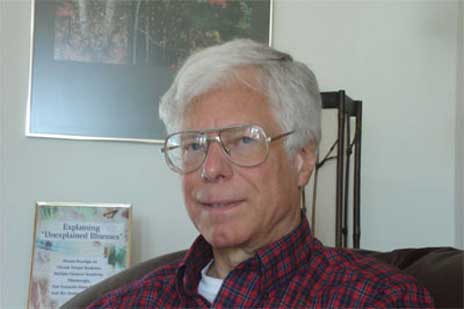
Hope for Patients with environmental illnesses? Bill to Fund Neuroendocrine Immune Disorder Center of Excellence in New Jersey
The New Jersey Assembly has unanimously passed Assembly Resolution 202 to fund a Center of Excellence in New Jersey for Chronic Neuroendocrine Immune Disorders – which include CFS, FM, MCS and related illnesses. The bill is now going to the New Jersey House as Senate Resolution 133.
The Research Center would be dedicated to ME/CFS, Fibromyalgia, Gulf War Illness, Lyme disease, Multiple Chemical sensitivity and other environmental illnesses
SENATE RESOLUTION No. 133
STATE OF NEW JERSEY
213th LEGISLATURE
INTRODUCED JUNE 22, 2009
Sponsored by:
Senator CHRISTOPHER “KIP” BATEMAN
District 16 (Morris and Somerset)
Senator LORETTA WEINBERG
District 37 (Bergen)
SYNOPSIS
Urges Governor and memorializes Congress to encourage establishment of research center in New Jersey dedicated to chronic neuroendocrine immune disorders.
CURRENT VERSION OF TEXT
As introduced.
A Senate Resolution urging the Governor and memorializing Congress to encourage the establishment of a research center in New Jersey dedicated to chronic neuroendocrine immune disorders.
Whereas, Neuroendocrine immune disorders (NEIDs) currently include Chronic Fatigue Syndrome/Myalgic Encephalopathy, Fibromyalgia, Gulf War illness, Lyme disease, Multiple Chemical Sensitivity Syndrome, and other environmental illnesses; and
Whereas, Chronic Fatigue Syndrome/Myalgic Encephalopathy, Fibromyalgia, Gulf War illness, Lyme disease, and Multiple Chemical Sensitivity Syndrome have been characterized as being as disabling as Chronic Obstructive Pulmonary disease, End-stage Renal failure, and Rheumatoid Arthritis; and as life-impairing as Multiple Sclerosis, AIDS, and cancer chemotherapy treatments; and
Whereas, The mechanisms of transmission of NEIDs include parasite-borne infections; and
Whereas, The similarity of symptoms of NEIDs imply a common pathophysiology of these illnesses; therefore, discoveries and advances made in the etiology and treatment of any one of these illnesses will be applicable and beneficial to the other NEIDs because of their common pathophysiology; and
Whereas, An estimated 20 million American adults and children suffer with NEIDs; and
Whereas, The time from illness onset to diagnosis of NEIDs is approximately three to seven years, except for Lyme disease which may take decades to diagnose; and
Whereas, There is mounting evidence of similarities of presentation and origins of NEIDs with Autism, Alzheimer’s disease, Multiple Sclerosis, Lupus, Parkinson’s and other autoimmune diseases; and
Whereas, Having a research center in this State is essential to: promoting research into the etiology of, and therapeutic interventions for, NEIDs; establishing treatment protocols and providing patient care for all individuals in the State of New Jersey afflicted with NEIDs; serving as a repository for NEIDs research data, patient data and research publications; serving as a resource for NEIDs researchers by sponsoring scientific meetings and encouraging discourse among researchers; serving as a tertiary resource for both physicians and patients in their efforts to manage NEIDs; and advancing both NEIDs research and patient care by disseminating the most recent advances in NEIDs research, diagnostics and treatment protocols; now, therefore,
Be It Resolved by the Senate of the State of New Jersey:
1. This House urges the Governor to encourage the establishment of a research center in this State dedicated to chronic neuroendocrine immune disorders.
2. This House respectfully memorializes Congress to encourage the establishment of a research center in this State dedicated to chronic neuroendocrine immune disorders.
3. Duly authenticated copies of this resolution, signed by the President of the Senate and attested by the Secretary thereof, shall be transmitted to:
a. Governor Corzine and the Commissioner of Health and Senior Services; and
b. The Majority and Minority Leaders of the United States Senate, the Speaker and
Minority Leader of the United States House of Representatives, and to every member of the United States Congress from this State.
STATEMENT
This resolution urges the Governor and respectfully memorializes Congress to encourage the establishment of a research center in New Jersey dedicated to understanding and treating chronic neuroendocrine immune illnesses (NEIDs) such as Chronic Fatigue Syndrome/Myalgic Encephalopathy (CFS/ME), Fibromyalgia, Gulf War illness, Lyme disease and Multiple Chemical Sensitivity Syndrome.
It is estimated by the Centers for Disease Control and Prevention (CDC) that CFS/ME affects between one and four million Americans and that 85% of individuals suffering with this debilitating and disabling illness have not been properly diagnosed. The economic impact and loss of worker productivity in the United States due to CFS/ME, alone, is estimated to be over $9 billion per year. Census data, and the incidence rate of CFS in the United States, projects that an estimated 28,000 to 30,000 citizens of New Jersey will suffer from CFS/ME. The symptoms of CFS/ME include flu-like symptoms (sore throat, fever, chills, tender neck and armpit lymph nodes, unrefreshing or non-restorative sleep, headaches, and post-exertional malaise lasting more than 24 hours), as well as body-wide muscle and joint pain, cognitive impairment, and short term memory loss.
The CDC reports that Fibromyalgia (FM) affects five million women, men, and children in the United States. FM is a condition characterized by body-wide muscle pain, tender points, sleep disturbance, cognitive impairment (“fibro-fog†or “brain fogâ€), overwhelming fatigue, swelling, joint pain, non-restorative sleep and migraine headaches.
According to the Research Advisory Committee on Gulf War Veterans’ Illnesses, Gulf War illness (GWI) is estimated to affect between 175,000 to 200,000 U.S. veterans, some of whom have been suffering for over 17 years. GWI is characterized by multiple, diverse symptoms that include a combination of memory and concentration problems, chronic headache, unexplained fatigue, widespread pain, chronic digestive problems, respiratory symptoms, and skin rashes.
The CDC has announced that Lyme disease is the fastest-spreading infectious disease in the United States, and that New Jersey ranks third in the nation for reported cases of Lyme disease. Yet, Lyme disease is seriously underreported in the United States. Current literature suggests that co-infections associated with Lyme disease play a major role in precipitating chronic illness with symptoms that include flu-like symptoms, extreme fatigue, skin rashes, unexplained weight gain or loss, other endocrine disorders, urinary problems, sexual and reproductive dysfunction, gastrointestinal dysfunction, heart problems, joint pain or swelling, muscle twitching and muscle pain, peripheral neuropathy, vision and/or hearing problems, disorientation, psychiatric disorders, cognitive dysfunction, disturbed sleep, and poor balance.
Multiple Chemical Sensitivity Syndrome and other environmental illnesses are estimated to affect 10% of the American population. These illnesses have a variable, and overlapping presentation with other NEIDs, and have symptoms that include any combination of extreme fatigue/lethargy, muscle/joint pain, sleep disturbances, headaches/migraine headaches, sensitivity to light and noise, dizziness/vertigo, poor memory/poor concentration, nausea/digestive problems, sore throat, constant coughing, wheezing, skin rashes or burning/stinging eyes.



